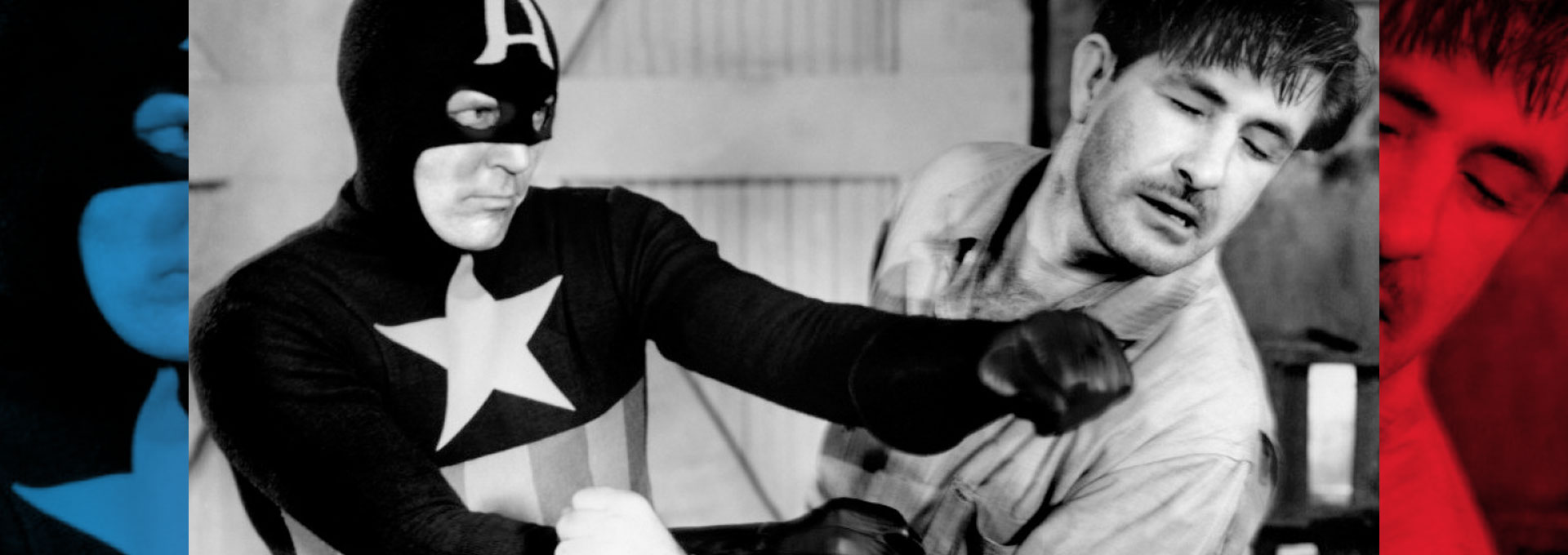Did you know that Captain America was the first Marvel (then Timely) character to make the leap to the big screen? It’s true, though the character may look and act a little different than the Cap audiences today know and love.

Seventy-five years ago, Captain America hit movie theaters throughout the country—in pieces. The very, very loose adaptation was presented in a 15-episode serial, which meant one episode, usually running about 15 minutes (the first clocked in around 26 minutes), would normally be paired with a feature film or other programming.
Forget about binging or streaming; if audiences wanted to see the entire picture, they’d have to come back to the cinema, usually every week, to catch the next heart-pounding episode! In this story, District Attorney Grant Gardner (that’s Captain America’s alias, which we’ll talk about in a bit) battles against the villainous Scarab who aims to procure gadgets with names like the “Electronic Firebolt” and “Dynamic Vibrator” that have the potential to be utilized as “super-weapons.”

Just as superheroes were enjoying their Golden Age in the comicbooks, they were also popular in serial format in Hollywood, particularly during the late 1930s and 1940s. Characters such as Flash Gordon, Batman, the Phantom, and the Spider, among many others, fought villains on screen week in and week out to the delight of audiences, many of which were kids. Republic Studios got in on the action too, with heroes including The Masked Marvel and Captain Marvel—no, not that Captain Marvel. The studio’s last superhero serial—and their most expensive, costing almost $223,000 (roughly $3.2 million today)—was Captain America.

If you get the chance to watch the 15-parter, you will find that Republic took a few artistic liberties with the material… well, let’s be real, they took several. First of all, Steve Rogers, who? In this tale, Captain America’s alias is DA Grant Gardner, played by actor Dick Purcell. Since the main character isn’t a solider (which is odd considering the picture was made during WWII and Steve Rogers was in the Army), the whole super-soldier serum experiment was thrown out the window, as well as the Nazis Rogers so famously fought in the comics.
Furthermore, Cap’s infamous shield vanished, replaced by a gun; if it’s any consolation, his belt buckle did feature a mini shield. The costume, which actually didn’t look drastically different than the comic art, is certainly nowhere near as dynamic as it appeared in bursting color on the pages of Captain America Comics. Since the movie was shot in black and white, the actual ensemble was dark blue, white, and gray, hues that translated better on black and white film. One noticeable change was that the wings apparent on Captain America’s cowl were absent in the movie, though they do appear in some promotional material.

The most prominent alterations—Gardner, the DA job, and the gun—did not go over well with Timely Comics. However, according to Republic, the sample pages Timely provided to the studio did not directly show that Cap was soldier Steve Rogers or that he didn’t use a gun. With production well underway by that point, there was no turning back without it costing a pretty penny. Historians gather that one reason for such significant changes from the get-go was that the initial script for the movie may have been based on a different comicbook character altogether (The Copperhead and Mr. Scarlet have been floated about) that fell through, thus the substitution of Captain America.

Captain America was filmed during October and November 1943, with an early 1944 release—movies were shot and distributed much quicker then. Though still working for Timely on the side, Stan Lee was serving in the US Army at that time, so it’s unlikely that he contributed any notes or feedback to the tale; we do know that he certainly didn’t make a cameo appearance in the film! Lead actor Purcell passed away of a heart attack in April 1944, so while the serial received positive feedback from critics, there would be no sequel, as least starring Purcell.
After the Captain America serial, more than 40 years would pass until the next Marvel character showed up in theaters in America. That honor goes to Howard the Duck (1986). As for Captain America the character, he wouldn’t appear on the big screen again until 1990’s Captain America, or if you count it, a 1973 Turkish movie 3 Dev Adam (3 Giant Men), in which the character appears without permission from Marvel. Cinematically, the rest is history!



